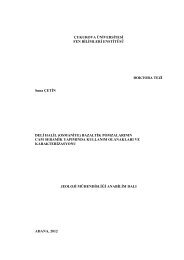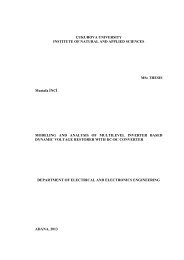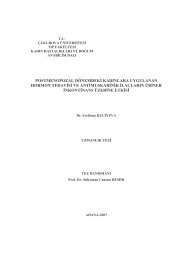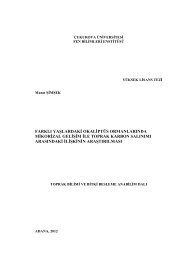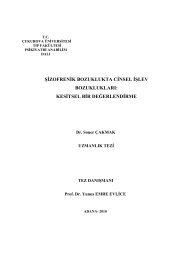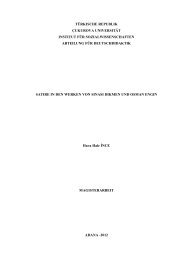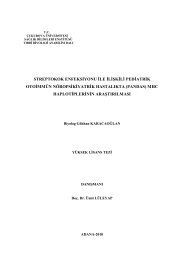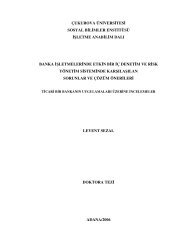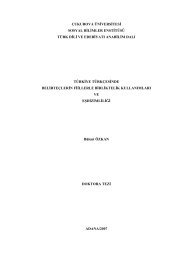Mentagrophytes - Çukurova Üniversitesi
Mentagrophytes - Çukurova Üniversitesi
Mentagrophytes - Çukurova Üniversitesi
You also want an ePaper? Increase the reach of your titles
YUMPU automatically turns print PDFs into web optimized ePapers that Google loves.
ABSTRACT<br />
COMPARISION OF IDENTIFICATION METHODS FOR THE<br />
DIFFERENTIATION OF TRICHOPHYTON RUBRUM FROM TRICHOPHYTON<br />
MENTAGROPHYTES<br />
Nowadays a rapid and striking change is observed in the taxonomy of<br />
dermatophytes. They are either re-grouped or re-named, in addition some<br />
varieties remain out of nomenclature giving origin to new species.<br />
The gold standard in laboratory diagnosis is sequencing analysis. But<br />
dermatophyte species are identified at the level of species according to colony<br />
characteristics, microscopic morphologies, growth requirements, physiological and<br />
biochemical characteristics due to infer-structural needs and high cost of<br />
molecular based researches. As changes are observed for a single dermatophyte<br />
species both for its morphology (colony pattern, pigments and growth rate) or<br />
physiology (in vitro hair perforation) and for its genotype (rRNA and mating<br />
patterns); the reliability of the method is questioned.<br />
Many micro-organisms belonging to Trichophyton rubrum complex are<br />
renamed i.e., T. fischeri, T. kanei, T. raubitschekii and similar are identified.<br />
Trichophyton interdigitale, and other micro-organisms pertaining to Trichophyton<br />
mentagrophytes sensu lato are re-classified by sequencing analysis. But one of the<br />
principal problems observed in mycology laboratory is the differentiation of T.<br />
rubrum from T. mentagrophytes using classical diagnostic methods. This study<br />
aimed to discuss the efficacy of morphological, physiological and biochemical<br />
diagnostic tests used in the laboratory identification of micro-organisms pertaining<br />
to both complexes before the current classification, in addition to interrogate their<br />
reliability in routine laboratory practice.<br />
In the study, T. fischeri CBS 100081, T. fluvimunionse CBS 592.68, T. kanei<br />
CBS 289.86, T. kuryangei CBS 422.67, T. kuryangei CBS 517.63, T. kuryangei CBS<br />
518.63, T. pervesii CBS 303.38, T. raubitschekii CBS 202.88, T. raubitschekii CBS<br />
287.86, T. raubitschekii CBS 100084, T. raubitschekii CBS 102856, T. rodhainii CBS<br />
376.49, T. rubrum CBS 302.60, T. rubrum CBS 363.53, T. rubrum CBS 363.62, T.<br />
rubrum CBS 392.58, T. rubrum var. nigricans CBS 100237, T. megninii CBS 389.58,<br />
T. asteroides CBS 424.63, T. langeronii CBS 764.84, T. mentagrophytes CBS 318.56,<br />
T. mentagrophytes var. mentagrophytes CBS 110.65, T. mentagrophytes var.<br />
mentagrophytes CBS 160.66, T. papillosum CBS 347.55, T. quinckeanum CBS<br />
572.75, Arthroderma benhamiae (MT-) CBS 807.72, A. benhamiae (MT+) CBS<br />
808.72, A. simii (MT-) CBS 417.65, A. simii (MT+) CBS 448.65, A. vanbreuseghemii<br />
CBS 428.63 and A. vanbreuseghemii CBS 558.66 obtained from Centraalbureau<br />
voor Schimmelcultures (CBS), Utrecht, the Netherlans were used.<br />
Urease reaction (in broth, in tube-agar and Petri agar), in vitro hair<br />
perforation test (blond child hair, sheep and goat hair), growth in corn-meal agar<br />
and bromcresol purple-milk solids-glucose agar (BCPMSG), Tween opacity test,<br />
xiii



